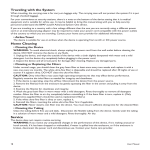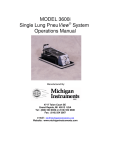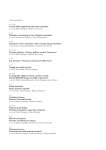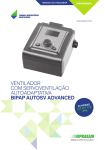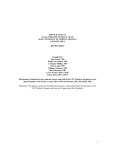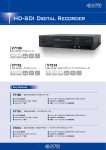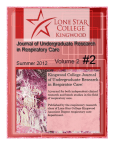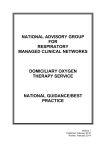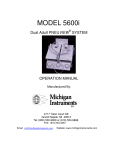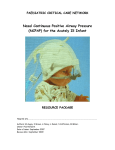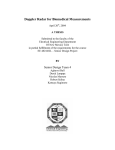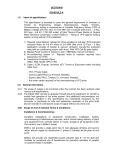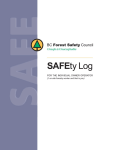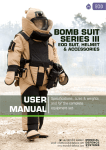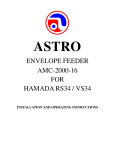Download noninvasive pressure support ventilation
Transcript
NONINVASIVE PRESSURE SUPPORT VENTILATION by Kevin T. Martin BVE, RRT, RCP V7116 HC 03 C RC Educational Consulting Servi c es, Inc. P.O. Box 19 3 0, Brockton, MA 0 2 3 0 3- 1 9 3 0 (80 0) 4 4 1-LUNG / (87 7) 36 7-NURS www.RCECS.com NONINVASIVE PRESSURE SUPPORT VENTILATION BEHAVIORAL OBJECTIVES UPON COMPLETION OF THE READING MATERIAL, THE PRACTITIONER WILL BE ABLE TO 1. discuss operational principles of noninvasive pressure support ventilation (NIPSV). 2. name the advantages of NIPSV. 3. describe indications for NIPSV. 4. compare and contrast indications and contraindications for NIPSV. 5. describe the complications of NIPSV. 6. explain how to determine the proper patient interface to deliver NIPSV. 7. provide initial patient set-up parameters for NIPSV. 8. describe techniques preformed to manage and monitor patients receiving NIPSV. 9. demonstrate critical thinking skills during a clinical practice exercise using the information gained in the reading material. . COPYRIGHT © 1995 By RC Educational Consulting Services, Inc. COPYRIGHT © April, 2000 By RC Educational Consulting Services, Inc. (# TX 4-020-348) Authored 1995 by Kevin T. Martin, BVE, RRT, RCP Revised 2001 by Michael R. Carr, BA, RRT, RCP Revised 2003 by Susan Jett Lawson, RCP, RRT-NPS Revised 2006 by Helen Schaar Corning, RRT, RCP Revised 2010 by Aimee D. Staggenborg, MA, BA, RRT Edited 2010 by RCECS Staff ALL RIGHTS RESERVED This course is for reference and education only. Every effort is made to ensure that the clinical principles, procedures and practices are based on current knowledge and state of the art information from acknowledged authorities, texts and journals. This information is not intended as a substitution for a diagnosis or treatment given in consultation with a qualified health care professional. This material is copyrighted by RC Educational Consulting Services, Inc. Unauthorized duplication is prohibited by law. 1 NONINVASIVE PRESSURE SUPPORT VENTILATION TABLE OF CONTENTS INTRODUCTION .......................................................................................................... 4 Ventilators Used For Noninvasive Positive Pressure Ventilation (NIPSV).................. 4 ADVANTAGES AND DISADVANTAGES OF NIPSV................................................. 7 INDICATIONS............................................................................................................... 7 Short-Term Ventilation .............................................................................................. 8 Long-Term Ventilation............................................................................................. 10 Nocturnal Ventilations.............................................................................................. 11 Beneficial Effects Of NIPSV .................................................................................... 11 Intermittent Use......................................................................................................... 12 CONTRAINDICATIONS............................................................................................. 12 COMPLICATIONS ...................................................................................................... 14 Exclusion Criteria For Successful NIPSV................................................................. 15 PATIENT SET-UP ....................................................................................................... 15 INITIAL VENTILATOR SETTINGS........................................................................... 16 MANAGEMENT AND MONITORING....................................................................... 19 Improve Oxygenation............................................................................................... 20 Improve Ventilation ................................................................................................. 20 Optimize Patient-Ventilator Synchrony .................................................................... 21 Weaning Criteria ...................................................................................................... 21 Noninvasive Positive Pressure Ventilator Adjustments............................................. 21 CLINICAL PRACTICE EXERCISE............................................................................. 22 2 This material is copyrighted by RC Educational Consulting Services, Inc. Unauthorized duplication is prohibited by law. NONINVASIVE PRESSURE SUPPORT VENTILATION Practice Exercise Discussion .................................................................................... 23 CONCLUSION............................................................................................................. 23 SUGGESTED READING AND REFERENCES .......................................................... 24 This material is copyrighted by RC Educational Consulting Services, Inc. Unauthorized duplication is prohibited by law. 3 NONINVASIVE PRESSURE SUPPORT VENTILATION INTRODUCTION N oninvasive ventilation has been difficult to achieve in the past. Conventional ventilators require a leak proof system to operate effectively. This is achieved by intubation or a tight-fitting facemask. Intubation is invasive and very uncomfortable, as are tightly fitted masks. Leaks are also common with masks. Mask continuous positive airway pressure (CPAP) systems have the same drawbacks. Today those disadvantages are corrected. Noninvasive ventilation is the delivery of ventilatory support without the need for an invasive artificial airway. Such ventilation has a role in the management of acute or chronic respiratory failure in many patients and may have a role for some patients with heart failure. Noninvasive ventilation can often eliminate the need for intubation or tracheostomy and preserve normal swallowing, speech, and cough mechanisms. The use of noninvasive positive-pressure ventilation (NPPV) in acute hospital settings and at home has been steadily increasing. This is possible due to continued development of new noninvasive ventilators and improved patient interfaces. Ventilators Used for Noninvasive Positive Pressure Ventilation In recent years, improved ventilator and mask designs have made noninvasive ventilation more practical. Ventilators, such as the Respironics BiPAP Vision and S/T-D (Respironics Corp.) have leak compensation mechanisms. Ventilating pressures can therefore be achieved and maintained without an absolutely leak proof system. Leak compensation also allows for a looser and more comfortable fit. Figure 1 illustrates examples of noninvasive ventilation systems. Figure 1: NONINVASIVE VENTILATION SYSTEMS BiPAP Pro 2 without Humidifier 4 BiPAP Pro 2 with Humidifier This material is copyrighted by RC Educational Consulting Services, Inc. Unauthorized duplication is prohibited by law. NONINVASIVE PRESSURE SUPPORT VENTILATION Used In Home Care BiPAP® Vision® BiPAP S/T-D The same manufacturer produces a nasal mask for use with the BiPAP S/T-D and Vision ventilators. It is easier to maintain a seal with the nasal mask than a conventional facemask. The patient is also able to talk, eat, and drink with the nasal mask in place. This enhances patient comfort and compliance considerably. “BiPAP therapy” may be used in many locations to describe noninvasive pressure support ventilation (NIPSV) combined with expiratory positive airway pressure (EPAP), regardless of the ventilator being used. Throughout this course, the term BiPAP is referenced to the Respironics ventilator. There is also the VPAP ST-A (ResMed, Inc.) and the GoodKnight 425ST Bi-Level Device (Puritan Bennett, Covidien) . The operating manual for the system being used should be consulted to see if inspiratory pressure support is actually provided. Bilevel positive pressure does not always mean pressure support is provided on inspiration. Bilevel simply means there are 2 levels of positive pressure; one level (usually higher) on inspiration and a different level (usually lower) on expiration. Both levels can be independently adjusted. The inspiratory positive airway pressure (IPAP) provided/regulated is determined whether pressure support is being provided to the patient, or not. The mechanism employed by the BiPAP S/T-D and Vision ventilators to maintain pressure is unique. It consists of a pressure-control valve that alternately restricts or enhances flow to the patient by allowing more or less leaking through the valve. If pressure in the circuit begins to rise above that set by the practitioner, the valve increases the amount of leak. Pressure is rapidly returned to the set value. If pressure begins to drop below the set value, the opposite occurs. The amount of leak is diminished by valve closure, allowing both flow and pressure to rise in the circuit. This material is copyrighted by RC Educational Consulting Services, Inc. Unauthorized duplication is prohibited by law. 5 NONINVASIVE PRESSURE SUPPORT VENTILATION This process is accomplished in a matter of microseconds, providing a very stable pressure environment. When the patient inhales, the valve narrows/closes and flow is increased to the patient. When the patient ceases to inhale, the valve widens/opens and flow is decreased to the patient. This allows pressure to drop to the expiratory level set. The point of zero flow is the trigger between the expiratory and inspiratory phases. Should a leak develop in the system, the BiPAP Visions and S/T-D simply readjust flow to maintain the set pressures. The system establishes a new baseline that takes into account the unintentional leak. Therefore it compensates for the inevitable small leaks that occur from a noninvasive interface. It is this unique ability to maintain pressures in the event of leaks that makes noninvasive ventilation with these ventilators more practical. The popularity of the two Respironics ventilators virtually ensures that other ventilator manufacturers will develop leakcompensation mechanisms in future designs. For a more detailed description of the operation of the BiPAP Visions or S/T-D ventilators, the reader is referred to the manufacturer’s operating manual. This course concentrates on the use of NIPSV in the acute care setting. The Respironics® systems, in general, are the most widely used, so they will be used in examples. Similar results are possible with other ventilators using other terminology. For example, inspiratory positive irway Pressure (IPAP) on the BiPAP ventilator may be pressure support ventilation (PSV) on others. Expiratory positive airway pressure (EPAP) on the BiPAP is similar to positive endexpiratory pressure (PEEP) on another ventilator. Continuous positive airway pressure (CPAP) on the BiPAP ventilator differs little from other CPAP devices (except for leak compensation). Please note the mechanism various ventilators or systems use to provide IPAP, PSV, EPAP, CPAP, and PEEP may differ considerably. A firm understanding of both the patient’s condition and the equipment being used will dictate what is the appropriate ventilator terminology or system for a given patient. A simplified comparison of the Respironics ST-D and Visions ventilators is shown in Table 1. Table 1: SIMPLIFIED COMPARISON OF THE RESPIRONICS ST-D AND VISIONS VENTILATORS ST-D IPAP 4-30 cm H2O EPAP 4-15 cm H2O Oxygen source - bleed-in VT accuracy +/- 15% Monitors: VT & patient leak Limited alarms: Hi/Lo pressure No graphics Modes: CPAP, spontaneous, spontaneous/timed, timed 6 VISIONS IPAP 4-40 cm H2O EPAP 4-20 cm H2O Oxygen source - internal module blended VT accuracy +/- 10% Expanded monitoring: VE, PIP, RR, Ti/Ttot, % pt. triggered breaths Expanded alarms: apnea, VE, high rate, low rate Waveforms and Bar Graphs Modes: CPAP and spontaneous/timed This material is copyrighted by RC Educational Consulting Services, Inc. Unauthorized duplication is prohibited by law. NONINVASIVE PRESSURE SUPPORT VENTILATION Fixed rise time Measures proximal pressure Rise time control Measures & regulated proximal pressure ADVANTAGES AND DISADVANTAGES OF NIPSV T he most obvious advantage to NIPSV is that there is no endotracheal or tracheostomy tube required. Consequently, there are no complications from the presence of an artificial airway. Patients are more comfortable without an airway in place and less sedation is needed. The patient retains normal swallowing and airway defense mechanisms. The cough effectiveness is not impaired and the glottis can seal the airway to prevent aspiration. Patient communication is greatly enhanced because speech is preserved. Lastly, NIPSV allows intermittent application of ventilatory support. There are disadvantages related to the lack of an artificial airway. The practitioner does not have ready access to the airway for suctioning, monitoring, or emergency ventilation purposes. Control over the patient’s oxygenation and ventilation status is not as assured as with intubation and mechanical ventilation. NIPSV uses technology that is simpler than what has been used in the past. This meets with some resistance in the clinical setting where one is used to everincreasing technology and control of the patient. Additional disadvantages are feelings of claustrophobia and suffocation in some patients when a facemask is used. Facemasks also increase the possibility of swallowing air and aspiration if it cannot be readily removed. If the mask can be readily removed and the patient is uncooperative, there may be numerous periods when they do remove the mask. If so, they may experience transient periods of hypoxia and hypoventilation. Lastly, if the mask is too tight, patient comfort will be compromised and skin ulcers may develop. There is increased advancement relating to patient comfort and the ability to achieve a minimal leak system. There are now many different types of “masks” designed for NIPSV. One can choose the best type of mask to achieve adequate ventilation and oxygenation, while allowing the patient to feel comfortable. There are full face masks, nasal masks, nasal prongs, and nasal pillows now available on the market from many manufacturers. INDICATIONS FOR NIPSV N IPSV is not a replacement for conventional ventilation, i.e., intubation and the use of assist-control, synchronized intermittent mandatory ventilation (SIMV) or other modes. NIPSV should be considered useful ventilatory assistance rather than full ventilatory support. Severely ill patients cannot be effectively managed with noninvasive ventilation. NIPSV helps the patient breathe but does not provide life support. Leaks are common and the mask can be dislodged or mal-positioned, which can be catastrophic if the patient becomes dependent upon NIPSV. NIPSV can be used for short-term, long-term, or nocturnal ventilation. It also can be used as an intermittent treatment for pulmonary hygiene, similar to intermittent positive pressure breathing This material is copyrighted by RC Educational Consulting Services, Inc. Unauthorized duplication is prohibited by law. 7 NONINVASIVE PRESSURE SUPPORT VENTILATION (IPPB) or positive expiratory pressure (PEP) therapy. Periodic usage is another application to help the patient rest in cases of respiratory insufficiency and increased work of breathing. Examples are neuromuscular disorders (muscular dystrophy or amyotrophic lateral sclerosis (ALS)) and severe chronic obstructive pulmonary disease (COPD). These patients can benefit from using NIPSV a few hours during the day and while they sleep, which helps to expel excess carbon dioxide that builds up from hypoventilation. Specific NIPSV criteria are not delineated at the present time. The following material should be considered guidelines only. NIPSV is indicated for patients with intact respiratory drives who need only partial ventilatory support. • neuromuscular disorders: Muscular dystrophy, spinal cord injuries, idiopathic hypoventilation syndrome, post-polio respiratory insufficiency, ALS or other neuromuscular diseases. • obstructive disorders: acute exacerbation of COPD, end stage cystic fibrosis • residual post-op anesthesia • drug overdose • post-extubation acute respiratory failure • post-op cardiac surgery • congestive heart failure (CHF), fluid overload & pulmonary edema • restrictive disorders: chest wall restriction such as kyphoscoliosis and severe obesity • to relieve respiratory muscle fatigue • to decrease work of breathing • do-not-intubate orders • nocturnal hypoventilation • as a weaning strategy Short-Term Ventilation Patients in CHF generally need ventilator assistance until diuretic and inotropic medications become effective. In these patients, EPAP maintains alveolar and airway patency and inspiratory PSV decreases the work of breathing. The application of intrathoracic positive pressure also reduces venous return and lowers ventricular preload. This lowers congestion, aids contraction, 8 This material is copyrighted by RC Educational Consulting Services, Inc. Unauthorized duplication is prohibited by law. NONINVASIVE PRESSURE SUPPORT VENTILATION and eases the cardiac workload of the heart. Therefore, NIPSV and EPAP lower both circulatory and ventilatory work. The added benefit of oxygen, up to 100% when needed, assists in decreasing cardiac work, reducing tissue hypoxia, and decreasing work of breathing. Patients with an acute exacerbation of COPD require short-term NIPSV until medications (antibiotics, bronchodilators, corticosteroids, and mucolytics) become effective. COPD patients already have hyper reactive airways. Introduction of an endotracheal tube during a crisis exacerbates this condition. The tube also stimulates secretion production and interferes with the patient’s ability to remove secretion, increases airway resistance, and increases the work of breathing. Needless to say, avoidance of intubation is a preferred option. The result is a substantial decrease in cost and length of hospital stay. (The hospital stay decreases an average of 12 days for patients treated with noninvasive ventilation.) Patients experiencing residual post-operative anesthesia and drug overdoses are candidates for NIPSV. These patients require short-term ventilation until the effects of the anesthesia/drug have worn off. Because they lack protection of their airway, and are therefore susceptible to aspiration, continuous monitoring of ventilator status must be provided to these patients. Noninvasive ventilation has obvious advantages in this situation. However, protection of the airway is priority. Patients who remain hypoxemic despite a high FIO2 delivered from various oxygen masks may benefit from NIPSV. NIPSV helps overcome airway resistance and ease inspiratory workload. It lowers the amount of pressure the patient needs to generate in order to achieve an adequate tidal volume (VT). Normally, one must generate 1 cm H2O pressure to move 100 ml of air. A 500 ml tidal volume is therefore generated with a pressure gradient of 5 cm H2O. The pressure gradient needed for a given tidal volume increases proportionally with lung disease. As airway or elastic resistance increases, the pressure gradient needed to breath also increases. To move the same volume of 500 ml it may take 10, 20, or 30 cm H2O in the patient with lung disease. NIPSV relieves the patient of having to generate the entire gradient by him/herself. Expiratory pressure, with or without NIPSV, recruits alveoli into gas exchange and increases functional residual capacity. This further decreases the work of breathing by decreasing elastic resistance. The result of decreased work, decreased resistance and alveolar recruitment is improved oxygenation. This allows FIO2 to be lowered into a less toxic range. A lack of improvement in oxygenation and ventilation after 24 hours of NIPSV suggests intubation may be more appropriate. Carbon monoxide poisoning has traditionally been treated with as close to 1.0 FIO2 as possible with a non-rebreathing oxygen mask. The Respironics Visions is capable of delivering the high FIO2 and providing PEEP and ventilation. Using PEEP requires monitoring of the cardiac output to avoid decreased oxygen delivery to the tissues. Decreasing O2 tissue delivery will This material is copyrighted by RC Educational Consulting Services, Inc. Unauthorized duplication is prohibited by law. 9 NONINVASIVE PRESSURE SUPPORT VENTILATION compromise the treatment for carbon monoxide poisoning. If conscious sedation of a patient has gone awry, he/she can benefit from short-term oxygenation and ventilation. The Visions can deliver a 100% O2 source gas. The Visions provides leak compensation that is superior to the S/T-D and a nebulizer may be placed in-line and has definite advantages. Although flow characteristics may be affected, the practitioner may consider using heliox via this mode of therapy for the patient in acute asthma exacerbation. The National Association of Medical Directors of Respiratory Care (NAMDRC) site some specific indications to assist other physicians in determining which COPD patient is most likely to benefit from NIPSV. Those with significant hypercapnea (PaCO2 > 55), those who desaturate at night (SpO2 < 88 for 5 continuous minutes during oxygen therapy of 2 L/M) and those who reported symptoms of fatigue, dyspnea and morning headaches were sited by NAMDRC to benefit the most from NIPSV. It is not unusual for the post-op cardiac surgery patient to have bouts of fluid overload and pulmonary edema post-extubation. These are usually resolved quickly, but the patient must be assisted for short periods. NIPSV allows short-term assistance noninvasively and is often administered to these patients. Post-extubation acute respiratory failure (ARF) is another indication for NIPSV. Generally, this is caused by a short-term problem, such as, glottic edema, laryngospasm, or pulmonary edema. NIPSV can mechanically dilate the airway until the problem spontaneously clears or vasoconstrictors and muscle relaxants become effective. NIPSV also decreases inspiratory work during the crisis. Long-Term Ventilation The phrase “long-term” ventilation is used here to mean the patient’s condition will not be reversed in a few hours or days. NIPSV, in some cases, is used to satisfy the patient’s wish not to be intubated. Patients with severe chronic neurological dysfunction and terminal disease, such as, end-stage COPD, lung cancer, end-stage cystic fibrosis, and human immunodeficiency virus (HIV) infection are potential candidates for NIPSV. It is more comfortable and less costly than traditional ventilation and is a viable option for some of these patients. Nocturnal Ventilation Some patients with less severe neuromuscular or musculoskeletal problems also benefit from NIPSV. However, these patients generally fall in the nocturnal ventilation category. Ventilatory assistance during sleep relieves respiratory muscle fatigue that accumulates during waking hours. This improves daytime functioning of the respiratory muscles. 10 This material is copyrighted by RC Educational Consulting Services, Inc. Unauthorized duplication is prohibited by law. NONINVASIVE PRESSURE SUPPORT VENTILATION Nasal and mask CPAP have been used for many years in the treatment of sleep apnea syndromes. The addition of PSV allows for the relief of both obstructive and central sleep apnea symptoms. In addition, other conditions also benefit from nocturnal ventilatory assistance. Patients with COPD and cystic fibrosis who are placed on nocturnal ventilation have improved daytime symptoms. Patients with restrictive pulmonary disease, such as kyphoscoliosis, report the same results. All patients suffer a slight drop in oxygenation and rise in CO2 when they are asleep. For most patients, these changes are insignificant. However, they are significant for patients with borderline pulmonary status. Significant fluctuations of blood gases disrupt normal sleep patterns. Nocturnal NIPSV prevents these fluctuations in ventilatory status and improves sleep patterns. This, in turn, improves daytime endurance of the patient. Nocturnal NIPSV unloads respiratory muscles from the work they have done during the day. Patients with pulmonary disease must work harder throughout the day to breathe. Fatigue accumulates in the muscles during the waking hours because of the increased work of breathing. Resting the muscles at night through NIPSV relieves this fatigue. The result of nocturnal relief is greater daytime efficiency of the muscle. There is an increase in PaO2 and decrease in daytime PaCO2 following nocturnal ventilation. Patients also report less dyspnea and fewer morning headaches following nocturnal ventilation. Beneficial Effects of NIPSV: • avoid the need for tracheostomy • lessen the incidence of nocturnal desaturation • improve blood gases and gas exchange • improve respiratory muscle strength and endurance • decrease inspiratory muscle fatigue by decreasing muscle energy expenditure • improve lung volumes • (nocturnal ventilation): improve daytime functioning and activity level and intellectual capacity and decrease morning headache (from CO2 retention) and somnolence (from lack of sleep during the night) Intermittent Use NIPSV can be used as a treatment device in patients with an ineffective cough and poor This material is copyrighted by RC Educational Consulting Services, Inc. Unauthorized duplication is prohibited by law. 11 NONINVASIVE PRESSURE SUPPORT VENTILATION inspiratory capacity. Positive airway pressure mechanically dilates the airway getting air behind secretions and obstructions. This enhances cough effectiveness. If expiratory pressure is used, there is improved aeration of poorly ventilated areas through the pores of Kohn. This also improves cough effort and decreases atelectasis. (There is no evidence at the present time that NIPSV is more effective than conventional bronchial hygiene techniques.) CONTRAINDICATIONS N IPSV should not be used in several situations/conditions (see Table 2). Patients who require ventilation for life support are not candidates for NIPSV. Such patients cannot tolerate an accidental disconnection or malposition of the mask. Patients with severe cardiac arrhythmias or significant hypotension are also not candidates for NIPSV. As with all positive pressure devices, venous return and cardiac output may be decreased with NIPSV. Additional contraindications to positive pressure ventilation, such as, bullous pulmonary disease and pneumothorax, also apply to NIPSV. Acute facial trauma and basilar skull fractures are contraindications. In trauma patients, an adequate seal cannot be obtained and the mask will be too painful for the patient. Skull fractures may lead to pneumocephalus if air dissects between the tissues. Generally, patients should be awake and cooperative for NIPSV. However, sleep is not an absolute contraindication since many patients benefit from nocturnal ventilation. Severe dementia is an absolute contraindication. Very confused or combative patients who cannot (or will not) follow commands are not candidates for NIPSV. Patients requiring high ventilating pressures are a relative contraindication. Ventilating pressures greater than 30 cm H2O are difficult to obtain with a noninvasive system. High ventilating pressures are also an indicator of severe disease. These patients are probably better treated by intubation and conventional ventilation. High FIO2 is also difficult to achieve with some noninvasive systems. Noninvasive monitoring of FIO2 is difficult and variable in most systems. (Keep in mind that NIPSV may allow FIO2 to be lowered in some patients.) If the patient remains hypoxic on NIPSV, intubation would be inevitable. Tidal volume varies on NIPSV, depending upon the patient’s inspiratory effort and pulmonary mechanics. Patients with rapidly changing pulmonary compliance have considerable fluctuation in tidal volume at a given NIPSV setting. These patients are better suited for volume-cycled ventilation. Hyperventilating patients (PaCO2 < 35 mm Hg) do not do as well on NIPSV as those with hypoventilation. This may be related to inadequate flow from the NIPSV system being used. Hyperventilating patients have a high minute volume demand that requires high flow rates. This may not be possible with some noninvasive systems. Patient anxiety in this population also may play a role in his/her response. It is of interest that patients with CO2 retention without major hypoxemia do better on NIPSV than those with major hypoxemia alone. NIPSV is contraindicated in patients with no cough reflex and swallowing dysfunctions. The patient must be able to adequately protect their airway since it won’t be sealed with an artificial 12 This material is copyrighted by RC Educational Consulting Services, Inc. Unauthorized duplication is prohibited by law. NONINVASIVE PRESSURE SUPPORT VENTILATION airway. Excessive secretions that require frequent suctioning and the presence of upper GI bleeding also are contraindications. A final obvious contraindication to NIPSV (via nasal mask) is obstruction of the nasopharyngeal airway. Significant nasal resistance from obstruction limits the effectiveness of nasal ventilation. This is of particular importance in the infant and pediatric populations where resistance is already high. A facemask may be more effective in these patients. TABLE 2: CONTRAINDICATIONS TO NIPSV • life support ventilation • severe cardiac arrhythmias • significant hypotension • bullous pulmonary disease • pneumothorax • facial trauma/skull fractures • severe dementia • high ventilating pressures • high or precise FIO2 necessary* • rapidly changing pulmonary compliance • hyperventilating patients* • no cough reflex/swallowing dysfunction • excessive secretions/upper GI bleeding • nasal obstructions* * relative contraindications, see text for further explanation. This material is copyrighted by RC Educational Consulting Services, Inc. Unauthorized duplication is prohibited by law. 13 NONINVASIVE PRESSURE SUPPORT VENTILATION COMPLICATIONS F ew complications have been reported with NIPSV. However, reported complications of NIPSV are those associated with positive pressure ventilation and mask CPAP. Some complications include decreased venous return, decreased cardiac output, pneumothorax, Aspiration is possible if a facemask is used. A nasal mask minimizes the possibility of aspiration. All NIPSV patients should also have intact upper airway reflexes to protect the airway. There may be gastric distention with swallowed air. Insertion of a nasogastric tube may be necessary, especially if the patient is using a full face mask. Generally, NIPSV pressures are not high enough to overcome esophageal sphincter pressures (approximately 20 to 25 cmH2O) so gastric distention may not be a problem. However, the patient must be monitored for this complication. Tissue breakdown is possible if the mask size is improper or the seal is too tight. The most common site of tissue damage is on the bridge of the nose (for nasal masks). In addition to utilizing the correct size mask and ensuring the seal is not too tight, tissue breakdown may be prevented and/or resolved with protective wound dressings on the bridge of the nose or by trying a different type of mask, nasal prongs, or nasal pillows. COMPLICATIONS WITH NIPSV • leaks around mask • skin reddening and breakdown • eye irritation from air leaks • dry nose and/or upper airway • facial discomfort • gastric distension If the patient does not feel comfortable with the therapy because of claustrophobia and skin irritation, try changing the interface to one that is more easily tolerated by the patient. The use of topical lotions and nasal sprays that contain steroids and antihistamines can be used to treat nasal dryness associated with the use of NIPSV. Humidifiers in-line can also alleviate this problem. Masks should be cleaned daily to remove dirt and facial oils. The occasional mouth breathing patient, whether it’s partially or all the time, presents the problem of pressure leaks. Chinstraps don’t seem to resolve the problem. Changing the interface to an oral-nasal mask may be required to prevent the leaks. 14 This material is copyrighted by RC Educational Consulting Services, Inc. Unauthorized duplication is prohibited by law. NONINVASIVE PRESSURE SUPPORT VENTILATION EXCLUSION CRITERIA FOR SUCCESSFUL NIPSV: • respiratory arrest • pneumothorax • uncontrolled arrhythmias • airway obstruction • unable to clear secretions • uncooperative • facial trauma • systolic blood pressure < 90 mmHg PATIENT SET-UP A s with most procedures, patient cooperation and understanding enhance compliance and success considerably. The importance of communication and reassurance in the initial stage of NIPSV administration cannot be overemphasized. Some patients are immediately comfortable with the mask and NIPSV while many take some time to get used to it. Do not overlook this period of conditioning. The first step in patient set-up is to obtain baseline monitoring parameters according to institutional or care setting policy. Suggested monitoring parameters are breathing frequency or respiratory rate (RR), heart rate, blood pressure, ABGs or oximetry, end-tidal CO2 (PETCO2), breath sounds and use of the accessory muscles of respiration. (Use of the accessory muscles is an indicator of increased work of breathing. NIPSV should reduce work and therefore decrease accessory muscle use.) Noninvasive positive pressure ventilation can be applied with a nasal mask, full-face mask, nasal pillows, nasal prongs, or mouthpiece with lip seal. The nasal mask may make the patient feel less claustrophobic and allows the patient to speak and expectorate without removal of the mask. Nasal masks are more comfortable and easier to keep in position than facemasks. There is also less danger of aspiration with a nasal mask. A facemask gives more consistent control of pressures if the patient breathes through the mouth. There are other advantages and disadvantages to each type of mask. Select the most appropriate for the patient. Carefully fit the mask selected. Mask type and size are critical to successful application and patient overall compliance with NIPSV. Both nasal and full-face masks should rest one-third to one-half the way down the bridge of the nose and snugly along the lateral border of the nose. If This material is copyrighted by RC Educational Consulting Services, Inc. Unauthorized duplication is prohibited by law. 15 NONINVASIVE PRESSURE SUPPORT VENTILATION they rest high on the bridge of the nose, leaks about the eyes are common. Facemasks should cover the mouth and nose completely; they should be neither too large nor too small, and should not interfere with the eyes or go below the chin. For nasal masks, choose the smallest that completely covers the nose. Masks that are too small will cause excessive pressure on the bridge of the nose. (As mentioned above, it is wise to place a patch of wound care dressing on the bridge to minimize pressure trauma.) Nasal masks should fit around the end of the nasal bone to just below the nares and above the upper lip. A spacer or forehead bumper is provided to be placed between the mask and the patient’s forehead, which improves the seal and patient comfort, and often is adjustable for a custom fit. If excessive pressure is required to seal a mask, you probably do not have the correct mask size. Understand the needs of the patient through leading questions to include or eliminate certain types of mask interfaces. Respironics and other manufacturers now have many types of masks: total facemasks; full-face masks; nasal masks and direct nasal pillow/prong type masks. Sizing and selection is now easier and more accurate than ever. Once the mask has been selected, attach the head strap to the mask. Place the mask on the patient and tighten the head strap. Tighten the straps until all significant leaks are eliminated and pressure from the straps is equally applied at all points of attachment harness. The BiPAP ventilator compensates for small leaks, so the mask need not be absolutely pressure tight. Other systems/ventilators used for NIPSV may require a tighter fit so there is no leak. Consult the operating manual regarding leak compensation for the system being used. Regardless of the system being used, have the patient move their head around in a normal range of motion after tightening the straps. Confirm the seal and position of the mask during and after movement. In some patients, particularly those who are anxious, it may be wise to hold the mask in place for 10-15 minutes before attaching the head strap. This allows the patient to become accustomed to the device. Hold the mask in place as if one were providing an IPPB treatment. During this time, the practitioner is titrating ventilator settings to the most effective and comfortable for the patient. More importantly, the practitioner provides reassurance to the patient during this time while they get used to the mask. Patient reassurance prevents many failures of noninvasive ventilation. INITIAL VENTILATOR SETTINGS I nitial settings depend upon the patient’s condition, the reason for NIPSV, and the system being used. If one is merely trying to improve oxygenation, or to treat obstructive sleep apnea (OSA), then continuous pressure (CPAP) alone may be sufficient. If partial ventilatory support is necessary, inspiratory pressure (PSV) must be provided. The more severe the problem, it becomes necessary to use the higher initial settings. The first decision is to decide upon whether the use of CPAP or IPAP/EPAP is chosen for the patient’s condition, initially. The following are suggestions for the BiPAP ventilator in the acute care setting. They are guidelines only; institutional policy, physician orders, and the manufacturer’s recommendations should be utilized for specific situations. 16 This material is copyrighted by RC Educational Consulting Services, Inc. Unauthorized duplication is prohibited by law. NONINVASIVE PRESSURE SUPPORT VENTILATION In the management of acute respiratory insufficiency/impending respiratory failure, one manufacturer recommends the initial settings of S/T mode, IPAP/EPAP of 10/4, backup rate of 4 to 8 (depending on the patient’s spontaneous rate), and rise time adjusted to patient comfort. The BiPAP ventilator is a continuous-flow device providing two levels of positive pressure. The EPAP setting determines the lower pressure level; the IPAP setting determines the upper pressure level. (In CPAP mode, only one level is provided.) The difference between the two levels is what determines actual ventilating (PSV) pressure. EPAP is therefore analogous to PEEP and IPAP analogous to PSV on conventional ventilators. Pressure within the circuit oscillates between IPAP and EPAP on inspiration and expiration. The initial CPAP setting is usually 5 cm H2O. The initial EPAP setting is usually 3 to 5 cm H2O. These are increased in 1-2 cm increments to achieve the desired clinical response. Desired clinical response may be the lowest RR, % saturation > 90%, PaO2 > 60 mm Hg, no apneic periods, least use of the accessory muscles, or others. Oximetry and ABG response are the most common tools to evaluate EPAP/CPAP settings. EPAP and CPAP prevent premature alveolar and small airway collapse and reopen previously collapsed alveoli. The result of alveolar recruitment and prevention of collapse is improved oxygenation. Oximetry and PaO2 should increase accordingly. In some systems, oxygen must be fed into the BiPAP system via O2 supply tubing. Therefore, in these cases, FIO2 can be difficult to achieve or maintain. Begin with a flow rate of 2-5 litres per minute (lpm) and adjust according to relief of patient symptoms and acceptable oximetry values. Bleed-in oxygen flow rates > 10-12 lpm may indicate another mode of therapy or intubation may be necessary. In systems such as the Visions, the practitioner may set an exact FIO2. The initial IPAP setting begins at about 5 cm H2O above the initial EPAP setting. This is 8.0 cm H2O on the BiPAP ventilator if the initial EPAP is 3.0 cm H2O. On most ventilators, the PSV setting automatically takes into account any expiratory pressure setting. This is known as PEEPcompensation. The BiPAP ventilator is not PEEP-compensated. If you want the patient to receive “x” amount of PSV, add “x” to the EPAP level for the initial IPAP setting. So an initial EPAP of 3 cm H2O plus PSV of 5 cm H2O = IPAP of 8 cm H2O. (If the system being used is PEEP-compensated, set initial inspiratory pressure at 5.0 cm H2O.) The peak pressure can be observed on the manometer. The peak pressure is important to monitor, and helps the practitioner determine if the device is PEEP-compensated or not. IPAP is usually increased in 2 cm increments to achieve the desired clinical response. As with EPAP, the desired clinical response can be evaluated many ways. Evaluation of PaCO2, PETCO2, RR, tidal volume, subjective relief of dyspnea, and use of the accessory muscles are some options. Each will be described below. Evaluation of the PaCO2 is the most accurate method of determining optimal IPAP ventilatory levels. However, it is invasive and costly. Normal PaCO2 is 35-45 mm Hg. Patients with COPD may have a normal PaCO2 higher than 45 mm Hg. Patients with chronic restrictive This material is copyrighted by RC Educational Consulting Services, Inc. Unauthorized duplication is prohibited by law. 17 NONINVASIVE PRESSURE SUPPORT VENTILATION pulmonary disease may have a normal PaCO2 lower than 35 mm Hg. Adjust IPAP to return the patient to the PaCO2 providing a normal pH. The PaCO2 providing a normal pH is an indicator of the patient’s normal/chronic ventilatory status. This may be 40 mm Hg for those with normal lungs, 50 mm Hg for those with COPD, or 30 mm Hg for those with restrictive disease. PETCO2 is far less accurate than PaCO2 and difficult to measure on non-intubated patients. Even under optimum conditions, PETCO2 often does not correlate with PaCO2. The amount of CO2 exhaled is governed by several interrelated factors. Changes in metabolic rate circulatory or ventilatory status will affect exhaled CO2. Exhaled CO2 is affected by production of CO2 by the tissues, transportation of CO2 by the circulation, and elimination of CO2 by ventilation Therefore, interpretation of the PETCO2 requires a careful review of the overall metabolic, circulatory, and ventilatory status of the patient. However, it is useful for trend monitoring and detection of gross changes in ventilatory status. PETCO2 is not recommended for determination of initial settings. It is more useful for monitoring the patient following initial setup. Monitoring of RR is the simplest and possibly the most effective method of determining IPAP levels. RR correlates well with work of breathing and degree of respiratory distress. If a patient has a high RR (in most patients) it generally means there is greater work of breathing or distress. Conversely, when work or distress decrease, RR also decreases. Adjust initial IPAP levels to achieve the lowest normal RR possible (without abolishing the patient’s ventilatory drive). Use of the accessory muscles is another good indicator of work of breathing and respiratory distress. It’s shown the greater the work or distress; the more muscle use is evident. Therefore, observation and palpation of the accessory muscles can be a useful indicator of the patient’s work of breathing. Adjust initial IPAP levels to achieve the least use of the accessory muscles. Patient subjective relief of dyspnea should also be considered when setting the initial IPAP level. In an alert patient, subjective relief is possibly the most important determinant of ventilator settings. The patient knows what his/her body feels like, and with noninvasive ventilation, the patient can relay those feelings to the practitioner. This is a unique concept to practitioners accustomed to nonverbal (intubated) ventilator patients. Adjustment of IPAP to achieve a specific tidal volume is difficult and not recommended. Patient tidal volume varies on NIPSV depending upon inspiratory effort, patient position, inspiratory flow, and other factors. To try and maintain an exact tidal volume is difficult under such conditions. However, one can trend changes in tidal volume achieved, and set a goal range of tidal volumes that are consistent with adequate ventilation for the patient. Generally an increase in IPAP will help the patient increase tidal volumes, decrease work of breathing, and decrease PaCO2. There are three modes of operation to choose from on the BiPAP ventilator: spontaneous, spontaneous/timed, and timed. It is very important to select one of these modes if you wish the patient to receive bilevel positive pressure. If the selection switch is left on IPAP the patient will receive IPAP only. If the selection switch is left on EPAP/CPAP the patient will receive CPAP only. Selecting one of the following modes tells the ventilator to provide bi-level pressures. 18 This material is copyrighted by RC Educational Consulting Services, Inc. Unauthorized duplication is prohibited by law. NONINVASIVE PRESSURE SUPPORT VENTILATION Spontaneous is what the term implies, spontaneous breathing. If the patient does not trigger the ventilator through spontaneous inspiratory effort, no NIPSV breaths are supplied. (There is no cycling between the EPAP and IPAP pressure levels.) The patient still receives PSV breaths in the spontaneous mode on BiPAP. On conventional ventilators, spontaneous modes imply no ventilator-assisted breaths. Spontaneous usually means a flow of gas is available to the patient but not pressure support. On the BiPAP, spontaneous mode means there’s no timer active to deliver a breath without spontaneous patient effort. The patient can still receive a pressure supported breath when the machine cycles to the IPAP pressure set on inspiration. Spontaneous/timed and timed modes allow for cycling of IPAP (a PSV breath) to be provided through a timer. Spontaneous/timed is similar to SIMV with pressure support and CPAP. If the patient does not trigger the ventilator within a given time period, a breath is provided. A back-up respiratory rate must be selected for the spontaneous/timed mode. Set the ventilator breaths per minute (BPM) control slightly below the patient’s spontaneous RR to ensure an adequate minute volume. The timed mode is similar to controlled ventilation. The ventilator regulates both inspiratory and expiratory times. BPM and percent of inspiratory time must be selected for the timed mode. Ventilator BPM is set slightly above the patient’s spontaneous RR. The BPM selected determines the total time for inspiration and expiration. The percent of inspiratory time control determines how long inspiration will be of the total time. For example, in 60 seconds a BPM of 20 means there are 3 seconds for inspiration and expiration. An inspiratory time of 33% means 33% of 3 seconds (1 second) is inspiration and 2 seconds are expiration. An inspiratory time of 50% at 20 BPM gives 1.5 seconds inspiration and 1.5 seconds expiration. Selection of an inspiratory time of 33% therefore provides an I:E ratio of 1:2, 50% gives a ratio of 1:1. Additional settings depend upon institutional/care setting policy and physician order. Patient disconnect and low pressure alarms must be set along with routine alarms, such as, heart rate, percent of saturation, etc. MANAGEMENT AND MONITORING M anagement of NIPSV consists of monitoring the patient’s response and titrating pressure levels accordingly. Unlike volume-cycled ventilation and intubation, there are no guarantees with NIPSV. Patient volumes can fluctuate significantly. In the acute care setting this requires frequent adjustment of settings. If oxygenation is low, one has several options. The first is simply to check for leaks in the system. Following that, FIO2/liter flow can be increased or EPAP/CPAP can be increased. A greater tidal volume via an increase in IPAP/PSV or an increase in the breaths per minute may also improve oxygenation. Conversely, a decrease in EPAP/CPAP improves oxygenation if over distention is suspected. Over distention from excessive expiratory pressure can decrease pulmonary blood flow. This lowers oxygenation. EPAP/CPAP should be decreased as the patient improves to prevent over distention. This material is copyrighted by RC Educational Consulting Services, Inc. Unauthorized duplication is prohibited by law. 19 NONINVASIVE PRESSURE SUPPORT VENTILATION TO IMPROVE OXYGENATION: • increase FIO2 or liter flow • increase EPAP or CPAP • increase IPAP or PSV • decrease EPAP or CPAP (if over distention suspected) There are several options to improve ventilation. Again, the first is to ensure there are minimal leaks in the system. Following that, one can increase IPAP/PSV levels, increase ventilator breaths per minute or increase inspiratory percent time. Conversely, lowering EPAP/CPAP levels improve ventilation if excessive pressures are being used. Excessive expiratory pressure increases air trapping and impedes ventilation. The obvious solution is a decrease in EPAP/CPAP to improve ventilation. TO IMPROVE VENTILATION: • increase IPAP or PSV • increase BPM • increase % inspiratory time • decrease EPAP or CPAP (if air trapping suspected) Institutional/care setting policy guides the practitioner in how much to increase or decrease settings. Generally, FIO2 is changed 5-10% or 1-2 lpm. EPAP/CPAP and IPAP/PSV settings are changed in 2.0 cm H2O increments. Because the system is noninvasive and subject to variable leaks, settings may have to be adjusted often. A change in patient position, level of activity, inspiratory effort, or respiratory pattern may require titration of pressure levels. Institutional/care setting policy also determines the amount of monitoring to be performed. The more critical the patient, the more extensive the monitoring is necessary. Obviously, ventilatory parameters, FIO2/liter flow, and vital signs will be monitored. Ventilatory parameters to monitor are mode, IPAP and EPAP setting, PSV level (IPAP-EPAP), percent inspiratory time (percent IPAP), set and spontaneous RR, high and low pressure alarm settings, estimated tidal volume and leak. The practitioner may note mask and spacer size and comment on skin integrity under the mask. Breath sounds and oximetry are other standard monitoring parameters. Baseline and periodic ABGs are wise. Oximetry and ETCO2 monitoring drastically reduce the number of ABGs necessary. Observation and palpation of the accessory muscles is another useful monitoring 20 This material is copyrighted by RC Educational Consulting Services, Inc. Unauthorized duplication is prohibited by law. NONINVASIVE PRESSURE SUPPORT VENTILATION parameter. Monitoring of RR via the vital signs is one of the most helpful monitoring tools since it is an indicator of patient work of breathing. TO OPTIMIZE PATIENT-VENTILATOR SYNCHRONY: • optimize tidal volume and/or PaCO2 • minimize accessory muscle use • alleviate dyspnea • decrease respiratory rate WEANING CRITERIA: • clinically stable for > 6 hours • respiratory rate < 24 BPM • heart rate < 110 bpm • compensated pH > 7.35 • SpO2 > 90% on < or = 3 lpm O2 TABLE 3: Noninvasive Positive Pressure Ventilator Adjustments1 Setting Adjustment Anticipated Result IPAP Increase Decrease Increase Increased tidal volume: increase ventilation/decrease PaCO2 Decreased tidal volume: decrease ventilation/increase PaCO2 Increased FRC, increased PaO2, decrease tidal volume, improved synchronization if intrinsic PEEP is present Decrease FRC: decrease PaO2, increase tidal volume, possible rebreathing of CO2 if EPAP <4 cm H2O Increase PaO2 Possible oral and nasal drying due to high flow of titrated O2 or high FIO2 Decrease PaO2 Increased minute volume in timed modes, decrease PaCO2 Decreased minute volume in timed modes, increase PaCO2 EPAP Decrease FIO2 Increase Rate control Decrease Increase Decrease This material is copyrighted by RC Educational Consulting Services, Inc. Unauthorized duplication is prohibited by law. 21 NONINVASIVE PRESSURE SUPPORT VENTILATION TABLE 4: CLINICAL PRACTICE EXERCISE The following practice exercise is discussed below. 1. The patient is a 67-year-old male admitted for shortness of breath. He has mild COPD. He is complaining of dyspnea, heart rate is 140, RR is 32, and BP is 150/120. Crackles are heard bilaterally. Oximetry is 85% on room air. Evaluate this information and make recommendations. ______________________________________________________________________________ ______________________________________________________________________________ ______________________________________________________________________________ ______________________________________________________________________________ ______________________________________________________________________________ 2. A chest X-ray reveals perihilar fluffy infiltrates, an enlarged heart, and prominent vascular markings. An ABG reveals pH 7.32, PaO2 50 mm Hg, PaCO2 60 mm Hg, HCO3 30 mEq/L, and 80% saturation on 3 lpm nasal cannula. The patient appears fatigued and chest movement has decreased. What are your suggestions and why? ______________________________________________________________________________ ______________________________________________________________________________ ______________________________________________________________________________ ______________________________________________________________________________ 3. The physician agrees with your suggestions. What are the initial settings for this patient? ______________________________________________________________________________ ______________________________________________________________________________ ______________________________________________________________________________ ______________________________________________________________________________ 4. Upon implementation, the patient’s RR decreases to 24 and oximetry increases to 85%. Evaluate this information and make recommendations. ______________________________________________________________________________ ______________________________________________________________________________ ______________________________________________________________________________ ______________________________________________________________________________ 22 This material is copyrighted by RC Educational Consulting Services, Inc. Unauthorized duplication is prohibited by law. NONINVASIVE PRESSURE SUPPORT VENTILATION Practice Exercise Discussion 1. Based upon the patient’s complaints and vital signs he is in acute distress. Bilateral crackles may be bilateral pneumonia, bronchitis or pulmonary edema. Oximetry indicates hypoxia. At this point, oxygen, ABGs and a chest X-ray are indicated. 2. The chest X-ray is compatible with CHF. ABGs reveal hypoxia and mild (for this patient) hypoventilation. The patient appears to be entering respiratory failure. Suggest diuretics and inotropics for the CHF. Suggest NIPSV with EPAP for hypoventilation and hypoxia. 3. Set IPAP/PSV to 8.0/5.0 cm H2O, EPAP/PEEP to 3.0 cm H2O, FIO2 to 3 lpm or 30-40%. The patient is spontaneously breathing, so setting a mechanical BPM isn’t necessary. A back-up rate can be used if desired. 4. A decrease in RR suggests a decrease in the patient’s work of breathing. An increase in oximetry suggests improved oxygenation. Titrate IPAP/PSV to the level providing the lowest acceptable spontaneous RR. Titrate FIO2 and/or EPAP to obtain oximetry > 90%. Caution must be taken in this patient to avoid over distention and possible abolition of hypoxic drive. CONCLUSION N ewer ventilator and mask designs have made NIPSV more practical and much more popular during recent years. NIPSV can be used for short-term, long-term, or nocturnal ventilation. NIPSV indications include: CHF, COPD, post-operative or sedation recovery, mild to moderate hypoxemia, post-extubation ARF and to avoid intubation for ethical or cost reasons. Contraindications to NIPSV include: life support ventilation necessary, severe cardiac arrhythmias or hypotension, bullous pulmonary disease, severe dementia, facial trauma/fractures, and hyperventilating patients. There are few complications to NIPSV and those that do occur are rare. Possibilities include: aspiration, gastric distention, and tissue damage from too tight of a mask. Nasal masks are preferred over facemasks. The initial EPAP setting is generally 3 –5 cm H2O. The initial CPAP setting is generally 5 cm H2O. The initial IPAP setting is generally 8 cm H2O. The initial O2 flow rate is 2-5 lpm. Titrate all the above to achieve the desired clinical response. Titrate EPAP/CPAP and FIO2 to achieve adequate oxygenation. Titrate IPAP/PSV to achieve the lowest RR and least use of the accessory muscles. This material is copyrighted by RC Educational Consulting Services, Inc. Unauthorized duplication is prohibited by law. 23 NONINVASIVE PRESSURE SUPPORT VENTILATION SUGGESTED READING AND REFERENCES Boucher, K. (2005). Veteran Therapist Praises Non-Invasive Ventilation. Advance for Respiratory Care Practitioners. Vol. 18, Issue 4, Page 6. Chasens ER; Ratcliffe SJ; Weaver TE. (2009). Development of the FOSQ-10: a short version of the functional outcomes of sleep questionnaire. SLEEP;32(7):915-919. Chatmongkolchart, S., Kacmarek, R. & Hess, D. (2001, March). Heliox Delivery with Noninvasive Positive Pressure Ventilation: A Laboratory Study. Respiratory Care Journal; 46(3):248-54. Donnellan, M. (2005). Avoiding Intubations - Nobody Said It Would Be Easy to Cut Number of Invasively Ventilated Patients. Advance for Respiratory Care Practitioners. Vol. 17, Issue 26, Page 21. Fernandez, D. (2004). Non-Invasive Positive Pressure: Ventilation Interface From Torture to Treatment. Advance for Respiratory Care Practitioners. Vol. 17, Issue 19, Page 33. Gold, W.M., Murray, J.F. & Nadel, J.A. (2002). Atlas of Procedures in Respiratory Medicine. WB Saunders Company. Lewis, S., Heitkemper, M., Ruff Dirksen, S., Graber O'Brien, P. & Bucher, L. (2007). Medical Surgical Nursing: Assessment and Management of Clinical Problems. Elsevier Science. Mason, R.J., Broaddus, V.C., Martin, T., King, T., Schraufnagel, D., Murray, J.F. & Nadel, J.A. (2010) Murray and Nadel’s Textbook of Respiratory Medicine, 5th edition. WB Saunders Company. Phillips Respironics, Inc. (2009) Bi-PAP AVAPS (Average Volume Assured Pressure Support) Non-Invasive Ventilatory Support, Product Information available at http://bipapavaps.respironics.com Phillips Respironics, Inc. (2009) Bi-PAP autoSV (servo-ventilation) Non-Invasive Ventilatory Support, Product Information available at http://bipapautosv.respironics.com Respironics, INC. BiPAP S/T User Manual. http://global.respironics.com/UserGuides/BiPAP_ST_User_Manual.pdf Talk About Sleep, Inc. (n.d.). Sleep Disorders. Available online at http://www.talkaboutsleep.com/sleep-disorders/index.htm Whitaker, Kent B. (2001). Comprehensive Perinatal and Pediatric Respiratory Care, 3rd edition. Delmar Learning. 24 This material is copyrighted by RC Educational Consulting Services, Inc. Unauthorized duplication is prohibited by law. NONINVASIVE PRESSURE SUPPORT VENTILATION Wilkins, R.L., Stoller, J.K. & Kacmarek, R.M. (2009). Egan's Fundamentals of Respiratory Care. 9th Edition. Elsevier Science. Wyka, K.A., Mathews, P. & Clark, W.F. (2001). Foundations of Respiratory Care. Delmar Learning. This material is copyrighted by RC Educational Consulting Services, Inc. Unauthorized duplication is prohibited by law. 25 NONINVASIVE PRESSURE SUPPORT VENTILATION POST TEST DIRECTIONS: Use the FasTrax answer sheet enclosed with your order to respond to all the test questions that follow. Leave the remaining answer circles on the FasTrax answer sheet blank. Be sure to fill in circles completely using blue or black ink. The FasTrax grading system will not read pencil. If you make an error, you may use correction fluid (such as White Out) to correct it. FasTrax answer sheets are preprinted with your name and address and the course title. If you are completing more than one course, be sure to record your answers on the correct corresponding answer sheet. RETURN TO: RCECS, P.O. Box 1930, Brockton, MA 02303-1930 or FAX TO: (508)-894-0172. 1. To evaluate the effectiveness of NIPSV, the patient MUST be assessed for a. b. c. d. e. use of accessory muscles. PaCO2. oximetry. respiratory rate. all of the above 2. The initial EPAP setting in general is usually a. b. c. d. e. 8.0 cm H2O. 7.0 cm H2O. 3 – 5.0 cm H2O. 10.0 cm H2O. none of the above 3. NIPSV is useful for ventilatory life support in most patients. a. True b. False 4. Nocturnal NIPSV for the COPD patient may result in a. b. c. d. e. 26 improved daytime PaO2. decreased daytime PaCO2. worsening daytime symptoms. a&b none of the above This material is copyrighted by RC Educational Consulting Services, Inc. Unauthorized duplication is prohibited by law. NONINVASIVE PRESSURE SUPPORT VENTILATION 5. Clinical contraindications to NIPSV include 1. 2. 3. 4. a. b. c. d. e. severe dementia. acute facial trauma. patient with mild hypoventilation. acute exacerbation of COPD. 2,3 3,4 1,2 1,2,3,4 1,4 6. The initial IPAP setting (when EPAP is set at 3.0 cm H2O on the BiPAP ventilator) is usually a. b. c. d. e. 11.0 cm H2O. 8.0 cm H2O. 3.0 cm H2O. 5.0 cm H2O. none of the above 7. A potential complication of NIPSV via facemask is a. b. c. d. e. aspiration. secretion mobilization. decreased PaCO2. improved PaO2. c&d 8. Which of the following are medical indications for NIPSV? 1. 2. 3. 4. a. b. c. d. post-extubation acute respiratory failures down’s syndrome acute exacerbation of COPD congestive heart failure 2,3,4 1,3,4 1,2,3,4 3 only This material is copyrighted by RC Educational Consulting Services, Inc. Unauthorized duplication is prohibited by law. 27 NONINVASIVE PRESSURE SUPPORT VENTILATION 9. To improve ventilation for a patient receiving NIPSV, the practitioner should 1. 2. 3. 4. a. b. c. d. e. increase IPAP/PSV. increase BPM/frequency. increase % inspiratory time. increase FIO2. 1,2,3,4 4 only 1,2,3 3,4 2,3,4 10. To improve oxygenation for a patient receiving NIPSV, the practitioner should a. b. c. d. e. increase IPAP/PSV. increase EPAP. decrease IPAP/PSV. increase FIO2. a, b & d 11. The initial setting used to manage acute respiratory insufficiency in a patient breathing spontaneously 12 times per minute is a. b. c. d. e. S/T mode IPAP/EPAP of 10/4 backup rate of 4-8 BPM all of the above none of the above 12. The main difference between the Visions and the S/T-D BiPAP models is that: a. b. c. d. The Visions can deliver 1.0 FIO2. The practitioner can choose the mode of ventilation. The practitioner can choose the respiratory rate. The S/T-D can be used for patients in respiratory arrest. 13. A patient whose diagnosis is LEAST LIKELY to require long-term NIPSV is one with a. b. c. d. 28 end-stage cystic fibrosis. post-polio syndrome. congestive heart failure. lung cancer. This material is copyrighted by RC Educational Consulting Services, Inc. Unauthorized duplication is prohibited by law. NONINVASIVE PRESSURE SUPPORT VENTILATION 14. A patient whose diagnosis will MOST LIKELY require long-term NIPSV is one with a. b. c. d. acute respiratory failure quadriplegia post-op coronary artery bypass graph drug overdose 15. Which statement(s) regarding CPAP and NIPSV is/are MOST TRUE? a. b. c. d. e. CPAP is generally used during the night for obstructive sleep apnea. NIPSV may be used during sleep for those with neuromuscular disorders. CPAP is the best choice for treating acute respiratory failure. a&b a&c This material is copyrighted by RC Educational Consulting Services, Inc. Unauthorized duplication is prohibited by law. 29 NONINVASIVE PRESSURE SUPPORT VENTILATION COURSE EVALUATION RC Educational Consulting Services, Inc. wishes to provide our customers with the highest quality continuing education materials possible. Your honest feedback will help us to continually improve our courses and meet state regulations. Responses to the following evaluation questions should be recorded in the far right hand column of the FasTrax answer sheet, in the section marked “Evaluation.” Mark “A” for Yes and “B” for No. Thank you. YES NO ______ ______ 1. Were the objectives of the course met? 2. Was the material presented in a clear and understandable manner? 3. Was the material well-organized? 4. Was the content presented without bias of any commercial product or drug? 5. Was the material relevant to your job? 6. Did you learn something new? 7. Was the material interesting? 8. Were the illustrations, if any, helpful? 9. Would you recommend this course to a friend? 30 This material is copyrighted by RC Educational Consulting Services, Inc. Unauthorized duplication is prohibited by law.





































